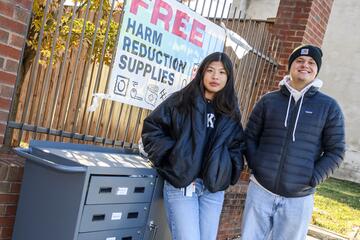Each year, American grocery stores are left with about five million tons of unsold food. Much of this product ends up in landfills or is incinerated, but sometimes a nonprofit will step in.
Let's Eat, Inc., is a mobile food pantry that serves the Greater Baltimore area. By rescuing and redistributing unsold food from local grocery stores, the organization's volunteers are able to reduce food waste and fight hunger in their home city, where 28% of residents currently struggle with food insecurity.
"It's mind boggling what's being thrown away, even still," said Let's Eat founder and president Catherine Morneault. "We are putting a dent in that. We'd like to put a bigger dent."
Let's Eat estimates that it will rescue a million pounds of food in 2025, helping roughly 17,000 people per month. Exact numbers are a little tricky. As a young organization composed entirely of volunteers, inventory tracking has always posed a challenge, especially when local stores call with unexpected donations.
Luckily, a team of six Johns Hopkins juniors are cooking up a solution.
Bryan Santana, Dhilan Patel, Griffin Montalvo, Justin Bravo, Simon Rupp, and Taran Agarwal, all of whom study computer science or computer engineering, have spent the past semester building a custom inventory app for Let's Eat. The project doubles as an assignment for their object-oriented software engineering class, where associate teaching professor Ali Madooei told teams of six to create an application from scratch.
"We had free rein to tackle any kind of issue or topic," says Rupp. "[But we needed something] more complex than a single page website. Something that can last us the whole semester and is enough for six people to collaborate on."
The team didn't have to think long. Morneault and Let's Eat board chairman John Scollan had recently come to speak in Santana's leadership theory class. The junior had been impressed by the ways they were helping Baltimore, even as the speakers noted the organization's struggles with inventory tracking.
So when the group was given official guidelines for the class project, Santana didn't waste any time.
"I immediately sent a message to the rest of my group and I said, 'I think this is something that would actually have a use,'" he say. "We're not just making an app for a grade and then ending it there. This can actually be something that impacts people. This app will exist outside of the class."
As the semester progressed, the students added more and more features to the app. Today, the dashboard can do more than just monitor how much food comes and goes. It can calculate monetary value and total weight, track the number of people helped, sort inventory by food type or intended purpose, and more.
According to board chair Scollan, this data is invaluable to a nonprofit, especially when they're soliciting donations or applying for grants.
"Sometimes I have maybe three or four minutes with a foundation, with a grant provider, to give them the story," he explains. "We'll be able to show donors and folks that are giving grants a true work out of the numbers, the weights, the number of people served, and all that kind of stuff. ... Going forward, it will be even more beneficial in ways that I may not totally be able to articulate yet. We will be able to analyze the data at the end of the year and really determine what we did right, what we did wrong, and I think it's going to help the overall nonprofit."
The app also allows food distributors that work with Let's Eat, like local shelters, to make accounts, streamlining communication and improving efficiency.
"Going into this project, we really wanted to focus on the users," explains Patel. "A lot of the time, when developers create features, they add things that would be cool to actually code and develop, but here we're focusing on who the beneficiaries are."
Morneault is enthusiastic for Let's Eat to start using the app, calling the students "wicked smart." Hopefully, she says, this tool will enable the food pantry to help Baltimore in new and expanded ways.
"Feeding people is just the beginning of the sentence. Our vision is community," says Morneault. "The more efficient we can be, the more transparent we can be, the better we will be."
Posted in Student Life, Community
Tagged community, food deserts








